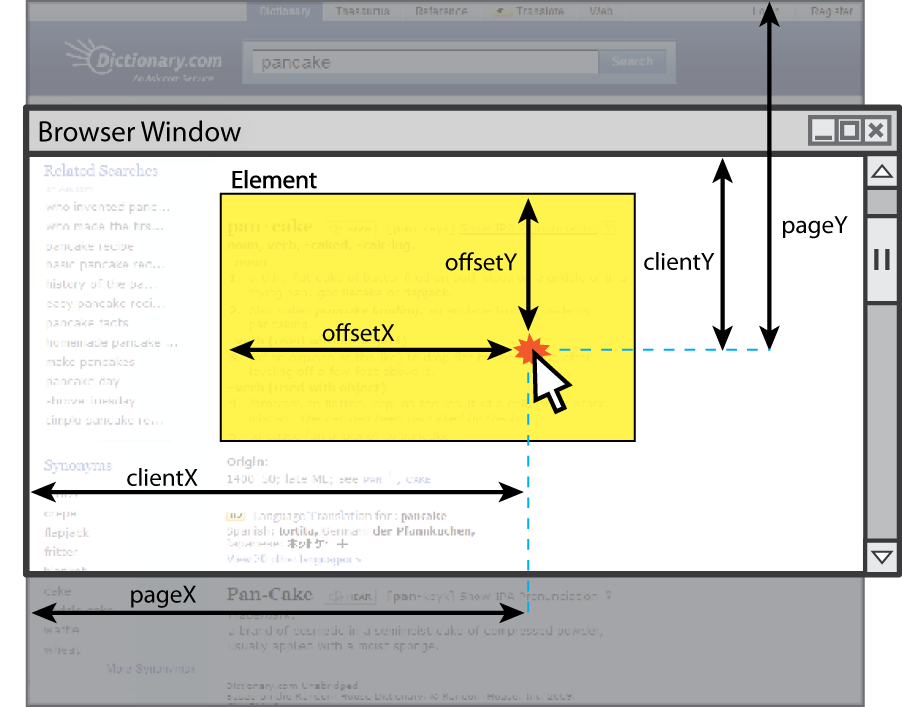Web Programming Step by Step
Lecture 16
Global DOM Objects; Events
Reading: 8.1; 9.1 - 9.2
Except where otherwise noted, the contents of this presentation are Copyright 2010 Marty Stepp and Jessica Miller.
8.1: Global DOM Objects
- 8.1: Global DOM Objects
- 9.2: Event-Handling
The six global DOM objects
Every Javascript program can refer to the following global objects:
| name | description |
|---|---|
document
|
current HTML page and its content |
history
|
list of pages the user has visited |
location
|
URL of the current HTML page |
navigator
|
info about the web browser you are using |
screen
|
info about the screen area occupied by the browser |
window
|
the browser window |
The window object
the entire browser window; the top-level object in DOM hierarchy
- technically, all global code and variables become part of the
windowobject - properties:
- methods:
-
alert,confirm,prompt(popup boxes) -
setInterval,setTimeoutclearInterval,clearTimeout(timers) -
open,close(popping up new browser windows) -
blur,focus,moveBy,moveTo,print,resizeBy,resizeTo,scrollBy,scrollTo
-
Popup windows with window.open
window.open("http://foo.com/bar.html", "My Foo Window",
"width=900,height=600,scrollbars=1");
window.openpops up a new browser window- THIS method is the cause of all the terrible popups on the web!
- some popup blocker software will prevent this method from running
The document object
the current web page and the elements inside it
- properties:
- methods:
- complete list
The location object
the URL of the current web page
The navigator object
information about the web browser application
- properties:
-
Some web programmers examine the
navigatorobject to see what browser is being used, and write browser-specific scripts and hacks:if (navigator.appName === "Microsoft Internet Explorer") { ...- (this is poor style; you should not need to do this)
The history object
the list of sites the browser has visited in this window
- properties:
- methods:
- complete list
- sometimes the browser won't let scripts view
historyproperties, for security
9.2: Event-Handling
- 8.1: Global DOM Objects
- 9.2: Event-Handling
JavaScript events
abort
|
blur
|
change
|
click
|
dblclick
|
error
|
focus
|
keydown
|
keypress
|
keyup
|
load
|
mousedown
|
mousemove
|
mouseout
|
mouseover
|
mouseup
|
reset
|
resize
|
select
|
submit
|
unload
|
-
the
clickevent (onclick) is just one of many events that can be handled -
problem: events are tricky and have incompatibilities across browsers
- reasons: fuzzy W3C event specs; IE disobeying web standards; etc.
- solution: Prototype includes many event-related features and fixes
Attaching event handlers the Prototype way
element.onevent = function; element.observe("event", function);
// call the playNewGame function when the Play button is clicked
$("play").observe("click", playNewGame);
-
to use Prototype's event features, you must attach the handler using the DOM element object's
observemethod (added by Prototype) - pass the event name as a string, and the function name to call
- handlers must be attached this way for Prototype's event features to work
-
observesubstitutes foraddEventListener(not supported by IE)
The event object
function name(event) {
// an event handler function ...
}
- Event handlers can accept an optional parameter to represent the event that is occurring. Event objects have the following properties / methods:
| method / property name | description |
|---|---|
type
|
what kind of event, such as "click" or "mousedown"
|
element() *
|
the element on which the event occurred |
stop() **
|
cancels an event |
stopObserving()
|
removes an event handler |
-
* replaces non-standard
srcElementandwhichproperties -
** replaces non-standard
return false;,stopPropagation, etc.
Mouse events (9.2.2)
click
|
user presses/releases mouse button on the element |
dblclick
|
user presses/releases mouse button twice on the element |
mousedown
|
user presses down mouse button on the element |
mouseup
|
user releases mouse button on the element |
mouseover
|
mouse cursor enters the element's box |
mouseout
|
mouse cursor exits the element's box |
mousemove
|
mouse cursor moves around within the element's box |
Mouse event objects
The event passed to a mouse handler has these properties:

| property/method | description |
|---|---|
clientX, clientY
|
coordinates in browser window |
screenX, screenY
|
coordinates in screen |
offsetX, offsetY
|
coordinates in element (non-standard) |
pointerX(), pointerY() *
|
coordinates in entire web page |
isLeftClick() **
|
true if left button was pressed
|
-
* replaces non-standard properties
pageXandpageY -
** replaces non-standard properties
buttonandwhich
Mouse event example
<pre id="target">Move the mouse over me!</pre>
window.onload = function() {
$("target").observe("mousemove", showCoords);
};
function showCoords(event) {
$("target").innerHTML =
"pointer: (" + event.pointerX() + ", " + event.pointerY() + ")\n"
+ "screen : (" + event.screenX + ", " + event.screenY + ")\n"
+ "client : (" + event.clientX + ", " + event.clientY + ")";
}
Move the mouse over me!
The keyword this
(8.1.3)
this.fieldName // access field this.fieldName = value; // modify field this.methodName(parameters); // call method
- all JavaScript code actually runs inside of an object
-
by default, code runs in the global
windowobject (sothis===window)-
all global variables and functions you declare become part of
window
-
all global variables and functions you declare become part of
-
the
thiskeyword refers to the current object
Event handler binding
window.onload = function() {
$("textbox").observe("mouseout", booyah); // bound to text box here
$("submit").observe("click", booyah); // bound to submit button here
};
function booyah() { // booyah knows what object it was called on
this.value = "booyah";
}
- event handlers attached unobtrusively are bound to the element
- inside the handler, that element becomes
this(rather than thewindow)
Fixing redundant code with this
<fieldset> <label><input type="radio" name="ducks" value="Huey" /> Huey</label> <label><input type="radio" name="ducks" value="Dewey" /> Dewey</label> <label><input type="radio" name="ducks" value="Louie" /> Louie</label> </fieldset>
function processDucks() {
if ($("huey").checked) {
alert("Huey is checked!");
} else if ($("dewey").checked) {
alert("Dewey is checked!");
} else {
alert("Louie is checked!");
}
alert(this.value + " is checked!");
}
- if the same function is assigned to multiple elements, each gets its own bound copy

